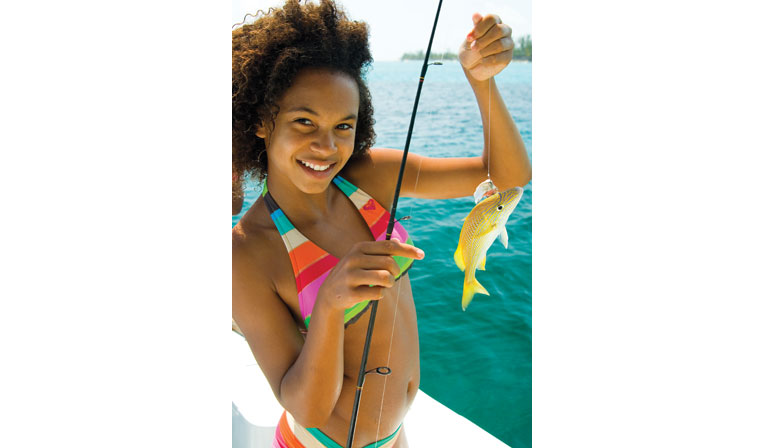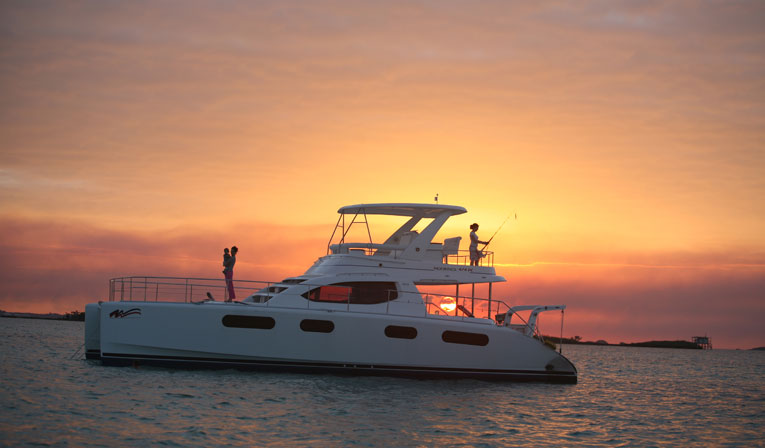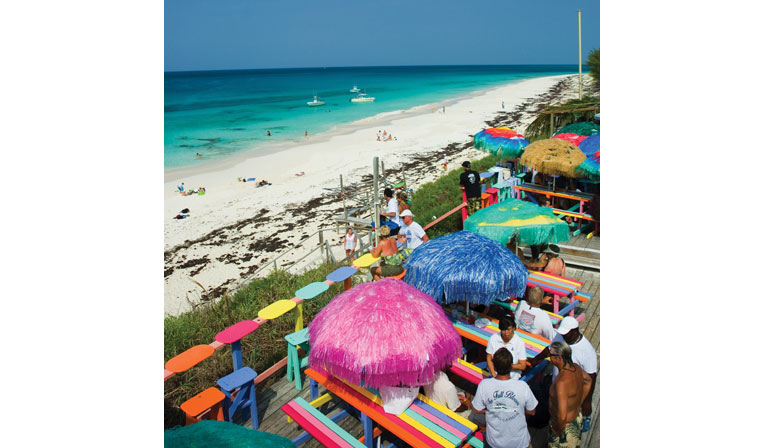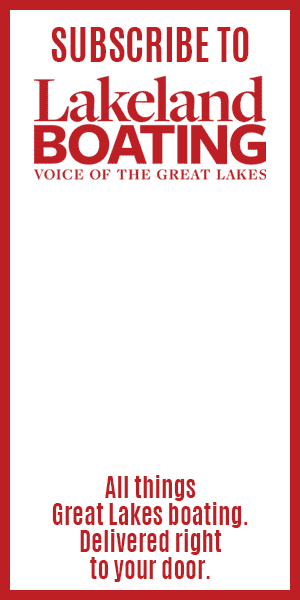Photo courtesy of The Moorings
A weeklong Bahamian charter vacation helps alleviate the wintertime blues.
I strolled along a crescent of beach on Fowl Cay, enjoying the softness of the white sand between my toes. I’d alternate, walking on hard, packed sand where the warm sea lapped around my ankles like bathwater; then shifting onto the dry, powdered sugar sand. In front of me, an oddly shaped stalk protruded from the beach. With a couple of tugs, I unearthed the sand-covered object. Wading knee-deep into the Bahamian sea, I rinsed my discovery and, like a magician unveiling a wonderful rose, the object morphed into a flawless conch shell, glowing scarlet on the edge of its fat lip. I knew it was going to be the perfect charter.
Golden Opportunity
The brochure had been intriguing: An announcement that The Moorings, the largest bareboat charter company in the world, recently put a fleet of powerboats in the Bahamas. An opportunity had been created for non-sailors to enjoy the delights of chartering, and it wasn’t long before we were on a Continental Express flight from Fort Lauderdale to Marsh Harbour, the social center of the Abacos, a necklace of islands that stretch along the north side of the Bahamas.
A quick taxi ride after cursory customs, and we were climbing aboard Goodnight Moon, our twin-hulled home for the next week. Our charter started the next morning, but we’d arranged to stay aboard the previous night to give ourselves a chance to stow gear and get acquainted with the boat. Sam, an ebulliently cheerful Moorings staffer, arrived bright and early the following day with her annotated copy of “Cruising Guide to the Abacos” and gave us a thorough check-out. It was invaluable insider’s advice on the best snorkeling, the best anchorages and the best food.
The fleet of Moorings 372PCs in the Abacos were created to Moorings specs by America’s Cup designers Morelli & Melvin and built in South Africa by the world-class Robertson & Caine yard. The thoughtful design provides comfortable accommodations for two couples, plus kids. Each hull is identical, with large double berths, private heads with electric toilets and stall showers. The salon joining the hulls features a big convertible dinette and galley with everything from microwave to refrigerator/freezer.
Best of all, the 372 has a 6kW generator that not only keeps the batteries charged and the microwave popping popcorn, but dual air conditioning systems keep the salon and cabins comfortably cool, even on the hottest days. Up an easy flight of stairs is the bridge, with ample seating and a helm shaded by a bimini top.
Standard equipment is very comprehensive, including a propane barbecue grill, flat screen TV/DVD, stereo with CD, snorkeling gear, more than ample linens and towels, and full electronics—from chartplotter/GPS to VHF radio. In the Abacos, the depthsounder is useful but a little frightening until you get used to the fact that the water is so shallow that much of your cruising is in 10 to 12 feet. Happily, the 372 draws just 3 feet, 2 inches of water and the props are guarded by twin skegs for protection against occasional groundings.

Photo courtesy of The Bahamas Ministry of Tourism
Abacos Chartering Tips
 How To Get There: Several airlines fly from Miami, Ft. Lauderdale and Palm Beach airports direct to Marsh Harbour in the Bahamas.
How To Get There: Several airlines fly from Miami, Ft. Lauderdale and Palm Beach airports direct to Marsh Harbour in the Bahamas.
Cost: Season is key, with the most expensive during the Christmas holidays and from late April to late June, while the low seasons are mid-August to mid-October and January through March. If you book dates immediately before or after a more expensive season, you’ll get the same weather at a discount. At press time, a 372 charters for about $3,500 in the low season and $5,000 in December high season. You should consider their Yacht Security Insurance at $60 a day (for peace of mind), and our fuel cost for the week was less than $300. If you want to tie up in a marina rather than anchoring, expect to pay from $1 to $2 per foot per night, plus electricity and water, depending on the season.
What To Take: Everyone takes too much, so pare down. In a soft-sided, easy-to-store duffel, pack a couple of swimsuits (so one can be drying), t-shirts, deck shoes, beach flip-flops and a light jacket for cool days in the off-season. In the Abacos, you’ll live in a swimsuit, but bring a nice shirt and shorts if you want to dine ashore. You’ll need a good hat, polarized sunglasses to see into the water and strong sunscreen to prevent burns. Take cameras, some CDs for the stereo and a canvas tote to carry gear ashore.
Must Reading: Let me immodestly suggest “Chartering A Boat,” written by yours truly and published by Sheridan House, available at bookstores everywhere.
Photo courtesy of The Bahamas Ministry of Tourism
Island Life
Unlike sailboat charters where prospective charterers need to document sailing experience that would daunt Horatio Hornblower, power charters are available to anyone with basic powerboat experience. And, if you aren’t comfortable at first with a boat of this size, The Moorings can provide a skipper for a day or two to hone your boat-handling and anchoring skills.
After stocking up with provisions at a local market (we chose to do our own provisioning rather than using the Moorings plan), we cast off to explore the Sea of Abaco. Our first stop was Fowl Cay, a Sam-recommended snorkeling and shelling spot where we anchored in 9 feet of water and dinghied onto the beach that provided the first of many conch shells. Later, after a pleasant lunch in the air-conditioned cabin, we upped anchor and cruised past Scotland Cay and along Great Guana Cay.
We decided to spend our first night at Orchid Bay Marina in Great Guana’s Settlement Harbour, a spotlessly maintained facility where we hooked up to shore power, took hot showers, barbecued steaks and enjoyed the first of the rum drinks we later dubbed “No Brainers” for their inevitable end result.
The next day, we listened in on the local cruiser’s VHF radio net, where boaters trade information on weather and sea conditions around the Abacos, as well as tips on marina deals, restaurant specials and even local flea markets. We’d planned to head for Green Turtle Cay, but our plans were changed by a local condition called a “rage sea.” The wind and swells sometimes create breaking seas in the passages between the Sea of Abaco and the Atlantic, making them impassable. In our case, the remains of a hurricane far to the north had created huge surf in Whale Cay Passage, and we would have to wait for another day to reach Green Turtle.
Instead, we walked into “town,” which is mostly a collection of cheerfully painted houses plus a good grocery that provided a few items we’d forgotten. A local conch vendor tended a table arrayed with his wares, but we were delighted with our own find and knew we’d discover more.
We used the afternoon to venture up to Baker’s Bay at the end of Great Guana, where we could clearly see massive breakers rolling through the passage in the distance. We anchored in water so clear we worried that our anchor would bonk the starfish we could see on the bottom, and again we explored the beach, discovering several additional conchs.

Photo courtesy of The Bahamas Ministry of Tourism
Kick Back and Relax
The rage continued the next day, so we opted to head for Treasure Cay, a luxury resort and marina on Great Abaco. En route, I let the autopilot steer while we enjoyed grilled cheese sandwiches and icy beers. Finding the entry was a bit tricky because it’s invisible until you’re close; but once inside, we picked up a transient dock right in front of the swimming pool. Shorepower and water were inexpensive, so I hosed down the boat to get rid of salt and sand, and we tucked in for the evening with the air conditioning keeping us pleasantly cool.
The next morning, we explored the Treasure Cay area, which lays claim to one of the best beaches in the world. That night, we dined ashore at the Tipsy Bar (aptly named if you sample their Goombay Smashes) where we enjoyed freshly caught lobster with crisp Caesar salads.
Afterwards, we headed for Elbow Cay and the harbor of Hope Town. Even with the chartplotter, the entrance is challenging. We got down to 5 feet of water (and some white knuckles!) before we slid into the pretty harbor marked by the candycane red-and-white-striped lighthouse.
We could have anchored in the calm harbor, but we opted for shorepower dockside rather than the generator at anchor, so we chose the Hope Town Marina, where the friendly dockmaster warped us into a slip with a nice view of the lighthouse. We shared hors d’oeuvres with a couple honeymooning on a Sea Ray at the next pier and, later, the steady sweep of the 138-year-old kerosene light (seen on everything from postage stamps to Bahamas currency) hypnotized us into a deep sleep.
We explored Hope Town by dinghy and foot the following day, marveling at the brilliantly painted houses that somehow managed to survive Hurricane Floyd’s 155-mph winds. We topped off our provisions (and rum) and headed out at mid-day for Man-O-War Cay nearby.
We anchored in the eastern harbor for lunch and decided to return to the Moorings base that night, since our charter ended the next morning and we had an early flight home.
It had been a relaxing charter, with none of the muscle needed to handle the lines on sailing charters (even our anchor windlass was electric!), the comfortably protected Sea of Abaco hadn’t challenged our skills, and we could recommend it to novice charterers wholeheartedly.
Whether your interests lie in snorkeling through gin-clear waters among squadrons of brilliant tropical fish, hunting conch shells on beaches where yours are the first footprints, or simply relaxing at anchor with a trashy novel, the Abacos have just what you want.
We’ll be back soon.





